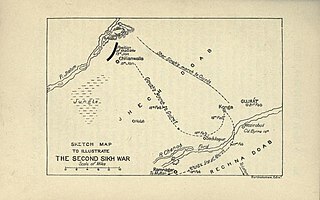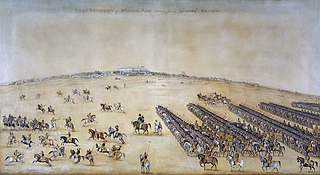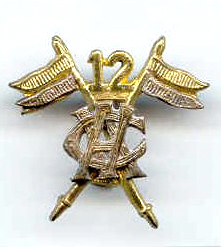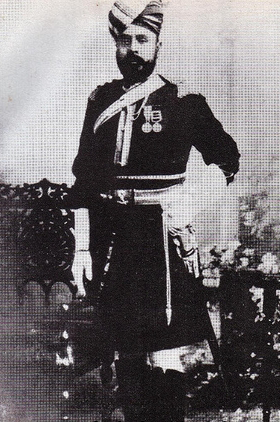
The second Anglo-Sikh war was a military conflict between the Sikh Empire and the East India Company which took place from 1848 to 1849. It resulted in the fall of the Sikh Empire, and the annexation of the Punjab and what subsequently became the North-West Frontier Province, by the East India Company.
The Tareen is a Pashtun tribe inhabiting southern Afghanistan, and western region of Pakistan.

The Sikh Regiment is an infantry regiment of the Indian Army. It is the most highly decorated regiment of the Indian Army and in 1979, the 1st battalion was the Commonwealth's most decorated battalion, with 245 pre-independence and 82 post-independence gallantry awards, when it was transformed into the 4th battalion, Mechanised Infantry Regiment. The first battalion of the regiment was officially raised just before the partial annexation of the Sikh Empire on 1 August 1846, by the British East India Company. Currently, the Sikh Regimental Centre is located in Ramgarh Cantonment, Jharkhand. The Centre was earlier located in Meerut, Uttar Pradesh.

4th Horse (Hodson's Horse) is a part of the Armoured Corps of the Indian Army, which had its beginnings as an irregular cavalry regiment during the time of the Indian Rebellion of 1857.

Clan Rattray is a Highland Scottish clan.

The 1st Horse (Skinner's Horse) is a regiment of the Armoured Corps of the Indian Army. It traces its origins as a cavalry regiment from the times of the East India Company, followed by its service in the British Indian Army and finally, after independence as the fourth oldest and one of the senior cavalry regiments of the Armoured Corps of the Indian Army.

The Bengal Army was the army of the Bengal Presidency, one of the three presidencies of British India within the British Empire.

The Deccan Horse or 9 Horse is one of the oldest and most decorated armoured regiments of the Indian Army. The Royal Deccan Horse , which was a regular cavalry regiment of the British Indian Army was formed from the amalgamation of two regiments after World War I. They saw service from the Mutiny of 1857 up to and including World War II.

The 12th Cavalry Sam Browne's Cavalry (Frontier Force) is an armoured regiment of Pakistan Army. It was formed in the British Indian army in 1922 by the amalgamation of 22nd Sam Browne's Cavalry (Frontier Force) and 25th Cavalry (Frontier Force).

The 4th Punjab Infantry Regiment was an infantry regiment of the British Indian Army formed on 18 April 1849 by Captain GG Denniss at Lahore as part of the Transfrontier Brigade, which became the Punjab Irregular Force (PIF) in 1851. The regiment was designated as the 57th Wilde's Rifles (Frontier Force) in 1903, and 4th Battalion (Wilde's) 13th Frontier Force Rifles in 1922. In 1947, it was allocated to the Pakistan Army, where it continues to exist as 9th Battalion The Frontier Force Regiment.

The 40th Pathans were an infantry regiment of the British Indian Army. It was raised in 1858 as the Shahjehanpur Levy. It was designated as the 40th Pathans in 1903 and became 5th Battalion (Pathans) 14th Punjab Regiment in 1922. In 1947, it was allocated to the Pakistan Army, where it continues to exist as 16th Battalion The Punjab Regiment.

The 45th Rattray's Sikhs was an infantry regiment of the British Indian Army. They could trace their origins to the 1st Bengal Military Police Battalion raised in April 1856, at Lahore, by Captain Thomas Rattray originally consisting of a troop of 100 cavalry and 500 infantry. The initial class composition of the troops was 50% Sikhs and 50% Dogras, Rajputs and Mussulmans (Muslims) from the Punjab and the North-West Frontier. It is said that he went through the villages challenging men to wrestle with him on the condition that they had to join up. Whatever the case, the regiment was raised and trained and developed as an elite corps, which soon saw action in Bihar in the Sonthal 'parganas'. After sterling service in Bihar, Bengal and Assam, and during the 1857 Mutiny, the cavalry portion was eventually disbanded in 1864 and the infantry section was taken into the line of Bengal Native Infantry as the '45th Native Regiment of Infantry'.

The 52nd Sikhs (Frontier Force) was an infantry regiment of the British Indian Army. It was raised in 1846 as the 2nd Regiment of Infantry The Frontier Brigade. It was designated as the 52nd Sikhs (Frontier Force) in 1903 and became 2nd Battalion (Sikhs) 12th Frontier Force Regiment in 1922. In 1947, it was allocated to the Pakistan Army, where it continues to exist as 4th Battalion The Frontier Force Regiment.

The Guides Infantry, or 2nd Battalion (Guides) The Frontier Force Regiment, is an infantry battalion of the Pakistan Army. It was raised in 1846 as part of the famous Corps of Guides, a highly mobile force to act as guides to troops in the field and gather intelligence beyond the borders of British India. The corps recruited men from various backgrounds, with Pathans, Punjabi Muslims, Sikhs, and Dogras forming the majority of their manpower. Under the leadership of Lieutenant Harry Burnett Lumsden, the Guides gained a formidable reputation and introduced the dust-colored "khaki" uniforms, later adopted by the British Army in India. The corps became part of the Punjab Frontier Force, known as Piffers, which maintained order on the Punjab Frontier for fifty years.

Khan Abdul Majid Khan Tarin (1877–1939), Khan-Sahib, OBE, was a prominent magistrate, MLA and philanthropist of the North West Frontier Province of former British India.
Tihlokar is a village in the Haripur area of Hazara, Khyber Pakhtunkhwa in Pakistan.

Risaldar-Major Mir Dad Khan, OBI, was from the Tareen tribe in Hazara region of the North West Frontier Province. He was a Risaldar Major in the British Indian Army. He was the father of former Pakistani president Ayub Khan and the Muslim League stalwart Sardar Bahadur Khan

Sardar Lehna Singh, Sardar Bahadur, (1825–1916) was a British Indian Army soldier and the Chief of the village Lehna Singhwala.















